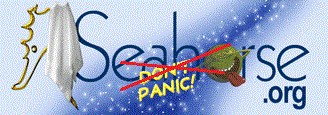| In order to determine
the sex and species of a seahorse, it's important to know
the something about seahorse anatomy. The following illustrations
and descriptions will help you learn the basics of the external
anatomy of seahorses.
Part 1 Orientation
 Figure
1 shows the areas of a seahorse and the terms used to describe
them. The front view of a seahorse, looking into its face
or belly, is the ventral orientation. The view from behind
the seahorse is its dorsal orientation. The side view, used
here in the illustrations, is referred to as the lateral orientation.
The lower parts, or the lower section of any parts, are called
the posterior, and the upper parts, the anterior. Figure
1 shows the areas of a seahorse and the terms used to describe
them. The front view of a seahorse, looking into its face
or belly, is the ventral orientation. The view from behind
the seahorse is its dorsal orientation. The side view, used
here in the illustrations, is referred to as the lateral orientation.
The lower parts, or the lower section of any parts, are called
the posterior, and the upper parts, the anterior.
Part 2 Sections and Measurements
 The
sections of a seahorse are the head, trunk and tail. The length
of a specimen is measured from the first
trunk ring to the tip of the tail, or the combined trunk
and tail lengths. The head is measured from the tip of the
snout to just before the first
trunk ring. Snout measurement is made from the tip
of the snout to the gill
opening. The
sections of a seahorse are the head, trunk and tail. The length
of a specimen is measured from the first
trunk ring to the tip of the tail, or the combined trunk
and tail lengths. The head is measured from the tip of the
snout to just before the first
trunk ring. Snout measurement is made from the tip
of the snout to the gill
opening.
The depth of the chest is measured from the superior
trunk ridge to the keel.
Part 3 Parts
of the Body
 Trunk rings, one of the features used to determine the species
of the seahorse, are counted from the first (the uppermost
ring seen from the dorsal view) to the ring immediately above
the anal fin.
Trunk rings, one of the features used to determine the species
of the seahorse, are counted from the first (the uppermost
ring seen from the dorsal view) to the ring immediately above
the anal fin.
Trunk ridges are the vertical spines running down the back
of the seahorse from trunk to tip of tail (the superior trunk
ridge), the spine running down each side of the seahorse trunk
(the lateral trunk ridge), and the spine running along each
side of the keel from neck to anal fin (the inferior trunk
ridge).
The seahorse's means of propulsion are its pectoral fin,
located just behind the gill opening, and its dorsal fin,
which joins the trunk at the tail.
Tail rings are counted from the ring just below the anal
fin to the ring before the tip of the tail.
Part 4 Parts
of the Head
 Features of the head are
illustrated at the right. The coronet can be low and fairly
smooth, on some species, to tall with pronounced points on
others. Eye, nose, and cheek spines also differ in length
from species to species, and within a species, from specimen
to specimen.
Features of the head are
illustrated at the right. The coronet can be low and fairly
smooth, on some species, to tall with pronounced points on
others. Eye, nose, and cheek spines also differ in length
from species to species, and within a species, from specimen
to specimen.
All seahorses have independently orbital eyes, and a pair
of pectoral fins immediately behind the gill opening.
 Some
species of seahorses have spindly appendages, called cirri,
in the area of the facial spines and trunk ridges. Some
species of seahorses have spindly appendages, called cirri,
in the area of the facial spines and trunk ridges.
Part 5 Sexual
Characteristics
 The external anatomy of female and male seahorses differ,
a characteristic that is called sexual dimorphism. On the
female seahorse, the lower abdomen joins the tail at a sharp
angle and her anal fin is often higher and slightly larger.
The external anatomy of female and male seahorses differ,
a characteristic that is called sexual dimorphism. On the
female seahorse, the lower abdomen joins the tail at a sharp
angle and her anal fin is often higher and slightly larger.
On males, a brood pouch is found beneath the anal fin, and
when empty, tapers gradually to the tail. During courting
or when pregnant, the pouch is very pronounced and protruding.
It features a vertical opening into which the female deposits
her eggs, and from which fry emerge after gestation.
(See also Sexing Seahorses) |

